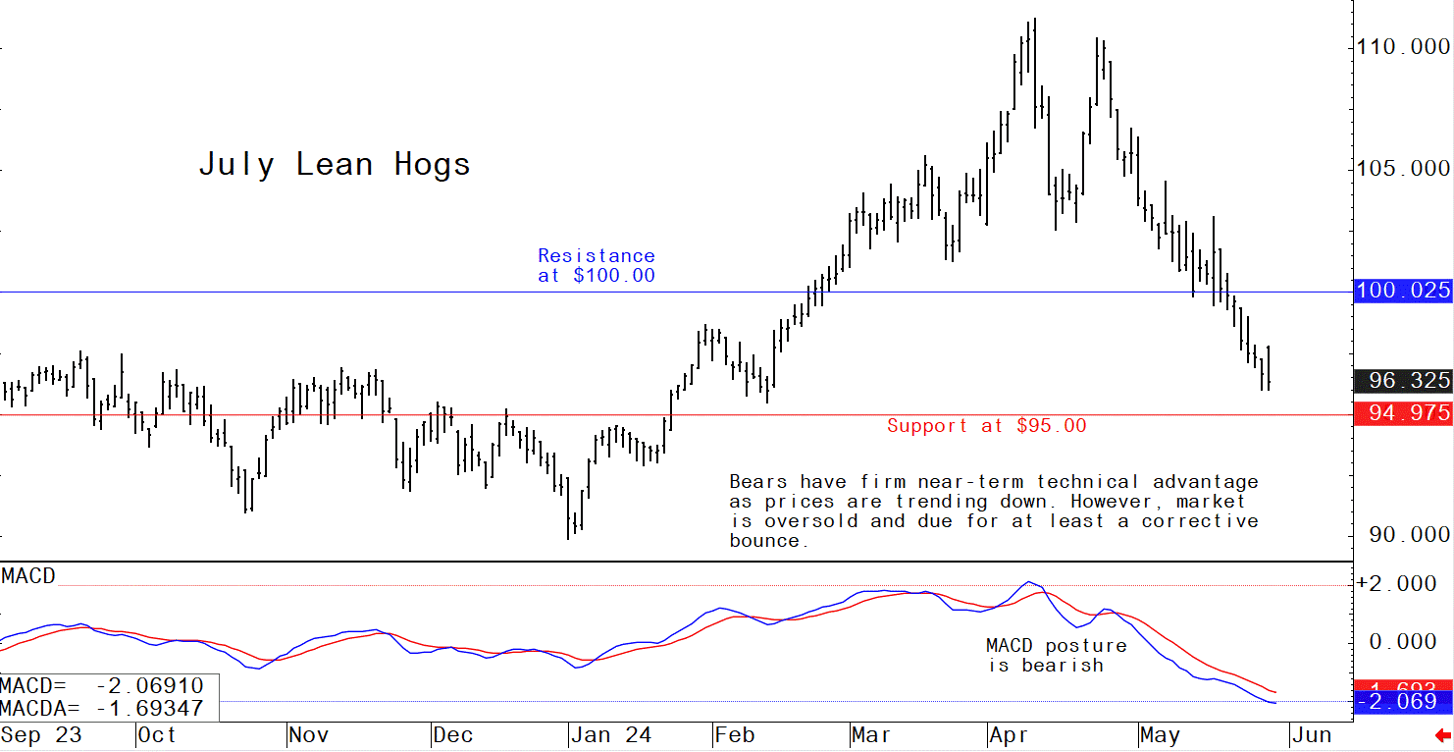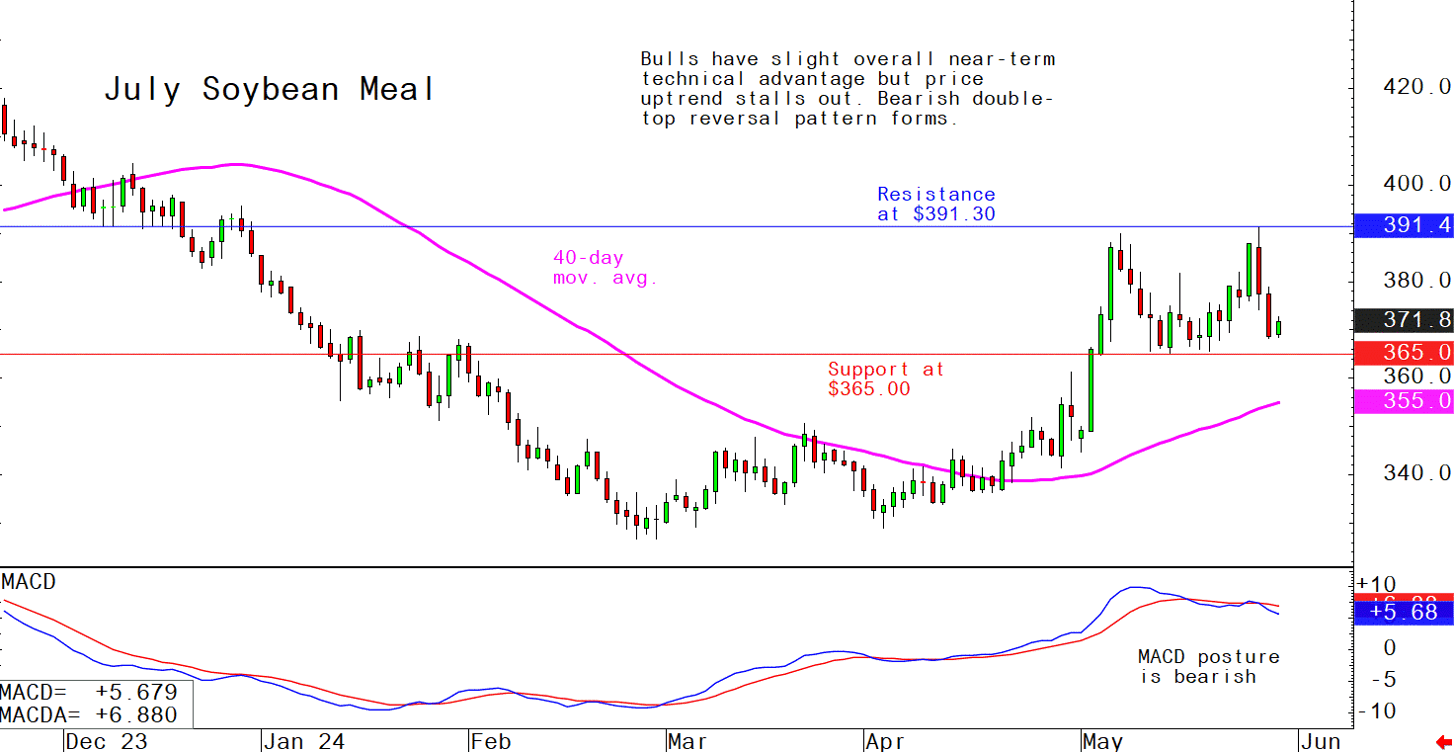



Pig outlook: Lean hog futures bulls continue to struggle
Livestock analyst Jim Wyckoff reports on global pig newsLean hog futures continue to fall under heavy selling pressure as the technical posture remains overall bearish. June hog futures hit a four-month low this week. However, the Relative Strength Index is still suggesting the hog futures market is close to a bottom. The latest CME lean hog index is down 47 cents to $90.79 as of May 28, marking the seventh straight daily decline. During that span, the cash index has dropped $1.50. Hog traders are pricing in a bearish outlook for the summer months. Hog futures bulls have a more optimistic outlook, anticipating a pick-up in US consumer demand in the wake of beef prices that persist at elevated levels.
Latest USDA and other news regarding the global pork industry
Agri Stats fails to dismiss DOJ meat price-fixing case
Agri Stats, an agricultural data company, lost its bid to dismiss a Justice Department lawsuit accusing it of facilitating price-fixing among major meat companies. This development marks a significant step towards trial.
The DOJ claims Agri Stats used data from chicken, turkey, and pork companies to aid price-fixing. While Agri Stats is the only defendant, nearly a dozen meat companies, including Tyson Foods, Cargill, Sanderson Farms, and Pilgrim’s Pride, are alleged co-conspirators. Agri Stats argues its data is anonymized, but the DOJ alleges it enables collective price increases affecting buyers like restaurants and consumers.
The case is crucial for the Biden administration's efforts to combat high food prices, attributed to market consolidation and "greedflation."
China’s sow herd shrinks
China’s sow herd totaled 39.86 million head at the end of April, down 0.1% from March and 6.9% below year-ago, the ag ministry reported.
US pork inventories built more than normal in April
USDA’s Cold Storage Report showed beef stocks totaled 430.7 million lbs. at the end of April, down 3.8 million lbs. from March, whereas the five-year average was a 21.6-million-lb. decline. Still, beef stocks stood 21.4 million lbs. (4.7%) below year-ago and 37.9 million lbs. (8.1%) under the five-year average. Pork inventories rose to 501.3 million lbs., up 38.2 million lbs. from March versus the five-year average increase of 18.8 million lbs. during the month. But pork stocks were still down 66.2 million lbs. (11.7%) from April 2023 and 56.8 million lbs. (10.2%) below the five-year average.
USMEF conference focuses on differentiation and long-term investment
The US Meat Export Federation (USMEF) Spring Conference in Kansas City which ends today put a strong emphasis on the quality and consistency of U.S. red meat as key factors for expanding the international customer base.
Randy Spronk, USMEF Chair, highlighted the importance of free trade agreements (FTAs) in creating global opportunities for U.S. red meat. He praised the market access gains from the U.S./China Phase One Economic and Trade Agreement and the U.S.-Japan Agreement. “Would we have found success in South Korea if U.S. beef was still tariffed at 40% and U.S. pork at 25%?” Spronk asked. “Would we have been able to develop Central and South America, or the Dominican Republic, into reliable destinations for U.S. red meat?" While they are not full-blown FTAs, Spronk also praised the market access gains achieved in the U.S./China Phase One Economic and Trade Agreement and the U.S./Japan Agreement. “With the weak yen and other headwinds in Japan, imagine trying to compete effectively there if U.S. beef and pork were still at a tariff disadvantage,” Spronk noted.
Dan Halstrom, USMEF President and CEO: Provided updates on export results, noting significant growth in pork shipments to Mexico and high export values for U.S. beef.
Randy Blach, CEO of CattleFax, emphasized the improvements in the quality of U.S. beef and the importance of long-term market development. He provided an update on the U.S. cattle industry’s herd rebuilding efforts and stressed the need for patience in expanding exports.
Daniel Whitley, USDA Foreign Agricultural Service Administrator, discussed USDA’s Regional Agricultural Promotion Program (RAPP), which aims to help U.S. exporters expand into new markets, particularly in Africa, Latin America, and Southeast Asia.
Kip Tom, former U.S. Ambassador, stressed the link between national security and food security, emphasizing the need for innovation and technology in agriculture to meet the global food production challenge projected by 2050.
Speakers, including Blach and Tom, emphasized that U.S. beef and pork are high-value products that stand out in the global market due to their quality, unlike the commodity-focused exports from countries like Brazil.
The next week’s likely high-low price trading ranges:
July lean hog futures--$93.00 to 100.00 and with a sideways bias
July soybean meal futures--$365.00 to $391.30, and with a sideways-higher bias
July corn futures--$4.50 to $4.75 1/2 and a sideways-higher bias
Latest analytical daily charts lean hog, soybean meal and corn futures











